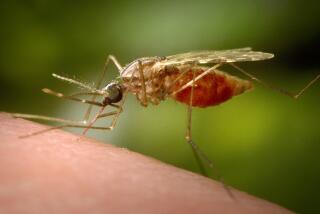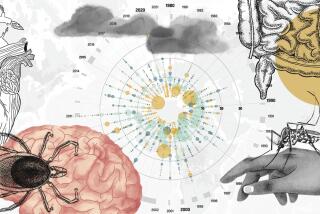Can Medicine Evolve as Fast as Diseases Will?
- Share via
When--not if--the next AIDS-like epidemic strikes, the “hot zone” may not be some exotic virus-rich ecosystem deep in the African jungle, but the congested pediatric ward of a Santa Monica hospital.
It’s a grim probability that highlights what could be called the “evolution revolution” in medicine: Epidemiology--the study of how disease spreads--is being transformed by a new perspective that focuses on how natural selection shapes disease.
The notion that the next great plague may be less likely to come from a rabid monkey on the veldt than an exhausted intern on pediatric surgery rotation in a suburban hospital may seem bizarrely counter-intuitive. But in fact it is completely consistent with what evolutionary theory would predict.
“I am as worried about First World pathogens coming out of hospitals than the Third World ones,” says Paul Ewald, an evolutionary biologist at Amherst College in Massachusetts and author of the recent book “The Evolution of Infectious Disease.”
Yes, a virus--or pathogen--removed from its natural setting might be able to run rampant in its new environment. But it is equally true that Darwinian notions of “survival of the fittest” apply as much to pathogens in hospitals as they do to animals in the wild.
Just as natural selection creates insects genetically invulnerable to all manner of pesticides, today’s hospitals have become breeding grounds where natural selection predicts that lethal pathogens will rapidly become resistant to the very drugs designed to stamp them out.
“To some extent, this is already happening,” acknowledges Stephen Morse, who specializes in emerging diseases as a virologist at Rockefeller University in New York. “We’re increasingly seeing antibiotic-resistant strains of tuberculosis and pneumonia in hospitals, for example. . . . We’ve had contaminated needles in hospital settings inadvertently transmit pathogens. Hospitals have become environments where new diseases can readily evolve.”
Partly as a result of this, the health care establishment has finally begun treating infectious disease as creatures of evolution. While it has yet to find its way into the formal curriculum of medical schools, evolutionary theory is forcing both doctors and public health officials to consider a whole new array of medical assumptions.
“Even many scientists believe that evolution means you become well-balanced with your environment,” says Ewald. “The reality is, natural selection doesn’t lead to being balanced--it leads to organisms that beat out their competitors.”
Indeed, he says, doctors have argued for decades that pathogens--no matter how virulent--invariably evolve into a state of mildness to coexist with their infected hosts. “By looking at the problem from an evolutionary approach,” Ewald notes, “we realize that it’s in error.”
In fact, durable pathogens can be both virulent and vicious. Depending upon the pathogen’s modes of transmission, it may have no genetic need for peaceful coexistence with hosts. In other words, evolutionary theory provides no intellectual support for the notion that a catastrophic epidemic will inevitably wind down to a milder form of the disease, as predicted by traditional epidemiological models.
At the same time, evolutionary theory can offer important guidelines on how to successfully intervene in the evolution of pathogens. “If we understand the forces shaping the evolution of disease organisms,” says Ewald, “we have the opportunity to take control of those forces to get the organisms evolving in the direction we want. Think of it as the domestication of the microorganism: We’re going to do to those organisms what we did to wolves. . . . Ultimately, we evolved dangerous wolves into being our pets.”
The challenge is to create mechanisms that consistently put the pathogen at a competitive disadvantage in the evolutionary sweepstakes. The issue is not so much eradication as negation. For example, Ewald cites the diphtheria vaccine as an unintended success in the evolutionary battle against a pathogen. The vaccine didn’t kill off diphtheria; it fomented a rival, a less destructive form of the disease that effectively co-opted diphtheria.
In the case of malaria, where numerous and expensive attempts have been made to create a vaccine, Ewald argues that the most cost-effective way to interrupt the pathogen’s evolutionary success would be to invest in mosquito-proof housing. That would lead to both fewer cases of the disease and lesser severity, he says. In effect, evolutionists argue, medicine needs to focus less on the nature of the disease and more on the nature of the pathogen.
By contrast, virologists such as Rockefeller’s Morse--who increasingly accept the evolutionary agenda--say we have too little information about emerging pathogenic threats to develop such strategies.
“We should be doing far more in terms of surveillance,” Morse says, “particularly in the surveillance of antibiotic-resistant bacteria.”
Morse points out that in both practice and policy, surveillance is handled on a state-by-state basis. There are no nationally coordinated efforts.
“In realistic terms, there need to be more and better connections between states on this,” he says. “The states are the infrastructure, and there has to be better data-sharing protocols. They do the best they can, but it’s spotty.”
The essence of the problem is that pathogens evolve far more quickly than the institutions designed to deal with them. It’s taken over a generation for the evolutionary paradigm to move into the sphere of public health policy. It’s taken the outbreak of AIDS to make the medical establishment more cognizant of the threat of emerging viruses.
The fundamental question remains whether natural selection favors our existing institutions--or whether new ones will ultimately evolve.
Michael Schrage is a writer, consultant and research associate at the Massachusetts Institute of Technology. He writes this column independently for The Times. He can be reached at schrage@latimes.com by electronic mail via the Internet.






